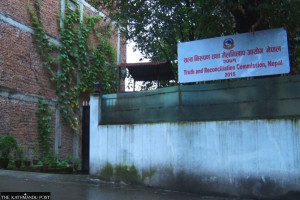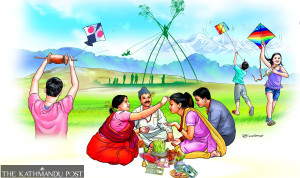Opinion
The forgotten children
Story of those born to Newar traders in Lhasa reveal what the Nepali state thought about the ‘Nepali’ identity
Amish Raj Mulmi
Reading into history can come with its own share of discoveries, however surprising they may be. Our focus on individual achievements in preserving the sovereignty of Nepal blinds us to other themes in history, especially to the stories of those who’ve been consigned to footnotes and barely appear in our readings. One of these is the story of Tibetan-Nepalis, individuals born to Newar traders who lived in Lhasa and their Tibetan wives. Applying the moral standards of the current era wouldn’t be entirely fair, but even by the standards of the day, their stories reveal what the Nepali state thought about the ‘Nepali’ identity, and on what grounds could one be considered a Nepali citizen.
The forsaken
First, the history: while the Newar trade with Tibet is much known, there is little we know about the larger socio-cultural impact of the trade, especially in the personal spheres. Newar traders (all of them men) lived in Lhasa and other Tibetan towns like Shigatse for years at a stretch. Leaving their wives behind in Kathmandu, they would often take a Tibetan woman as a second wife. ‘Most of the Nepalese residing in Tibet had married Tibetan women’, wrote Tirtha P. Mishra in his fascinating 2003 paperNepalese in Tibet: A Case Study of Nepalese Half-Breeds. The children of such relationships were termed ‘khacharas’, literally a mongrel. While any daughters born to such a relationship were considered Tibetans, the sons were considered as Nepali citizens.
With stringent Newar caste rules governing their social behaviours, although occasional cases of Tibetan-Nepali girls marrying into other Newar households in Kathmandu were reported, for the boys, it was an entirely different matter. ‘They were of course not welcome in their father's Kathmandu homes or in the valley, either, for the reason that they could under customary Nepalese law claim a share equal to that of the "pure" Newar sons from their father's estate,’ says Todd T. Lewis in his paper on Newar-Tibetan trade. Rejected by their fathers and Nepali society, they formed their own guthis in Tibet as a form of social cohesion after being refused entry to join the existing guthison grounds of impure parentage.
Although the sons were granted the ‘extraordinary’ privileges Nepali citizen enjoyed in Tibet, they didn’t have it easy. Occasionally used by the Nepali government as spies, as during the 1904 Younghusband Tibet expedition, ‘the striking feature’ of the policy towards khacharas was of “exploitation and lack of concern”,’ Mishra writes. They were ‘politically ignored, economically exploited and socially discarded by both Nepal and Tibet’, with Nepal government acknowledging them as citizens only ‘to exact tax and free labour’. ‘Even their legitimate grievances were ignored’, as during a plea to Chandra Shamsher about JitBahadur, the Nepali vakil (or representative) in Lhasa, who had not paid 70 individuals for the transportation of ‘50 bags of luggage’. The Tibetan government had little reason to care for those who were regarded as Nepalis and were often at the receiving end of hostilities towards Nepali traders. After China took over Tibet, it overturned the existing conventions and taxed Tibetan-Nepalis, even enrolling a few of them into its army, despite the protestations by Nepal. With the signing of a new Nepal-China treaty in 1956, the Tibetan-Nepalis were given a choice between Nepali and Chinese citizenship in 1962. According to anthropologist DorBahadurBista, a majority opted for the latter for several reasons, the primary being that Nepali property laws did not regard Tibetan-born Nepalis as legitimate offspring.
Conscribed to footnotes
Bista became Nepali consul in Lhasa in 1974, and his 1980 paper, ‘Nepalese in Tibet’, records the population of Nepalis in Tibet as approximately 500 at the time, a majority of them Tibetan-Nepalis. Most of them were ‘illiterate’ daily wage earners, with a few farmers. He records the testimonies of three such individuals born to Nepali fathers and Tibetan mothers, all of whom came to the consulate for help.
The first was a Tibetan-Nepali and his family, all of whom held Nepali passports, who wanted to move to Lhasa, as his herd of ‘sixteen yaks and five sheep’ was not adequate for him to feed his family, and said he would like to return to Nepal. ‘Upon inquiry, he admits that he has never been anywhere outside Tibet. He has no relatives or acquaintances in Nepal… They do not know who their ancestors were. Finally, he agrees that his return to Nepal would be even harder for him.’ The consulate eventually gave him some money out of the social welfare fund to pay off his debt.
The second was a case of property dispute between a Chinese commune and a Tibetan-Nepali that began with the latter’s cow entering a neighbour’s farm, and now the neighbour refused to entertain his requests to return the cow. Upon investigation, it was found that ‘[a]ll the land (in his village) had been turned into communal land except his own.’ Since he remained a Nepali citizen at this time, it was not obligatory for him to turn his land over to the state, he argued. Although he was advised to ‘seek accommodation’ with the other villagers, he ‘asserted he would rather return to Nepal’. Only when the consulate suggested he abide by the rules of the land he was living in did he relent.
The third was the leader of a group of five Tibetan-Nepalis, whose father was a ‘jyapu from Kathmandu’, and who had risen from poverty in pre-Chinese occupation days to wealth subsequently. His 15-year-old son studied in a Kathmandu boarding school, and his religiosity had continued under the recent Chinese occupation. ‘He had a private chapel in his Lhasa house...Lhasa authorities visited his house frequently and did not object to his religious practices.’ His testimony suggested that Tibetan-Nepalis had been receiving better treatment only recently. ‘The higher authorities always seem to make sure that the Nepalis get jobs, and are treated fairly and reasonably at all times… This was not quite the case for the past couple of years.’
Bista recounts meeting three other Nepali traders who had been in Tibet for long, and inevitably the discussion strayed to property rights and the Nepalis’ relationship with Tibetans. In one instance, Bista asks a Nepali trader on how to respond to Nepali claims of property and the debts Tibetans owed them. The trader simply said ‘no Nepali had ever gone to Tibet with a bagful of money’, suggesting that Nepali traders made money in Tibet by borrowing from Tibetans. He asked Bista to ignore such claims, as it would be ‘more profitable for you to not take any action.’
What makes a Nepali?
I came across these stories while reading up about the Newarmyth of 'Simhalasarthabahuavadana', a story that forms the base for all Newar traders to Lhasa. The myth, in itself a representation of the misogyny and moral hypocrisies that populate our caste system, reduces Tibetan women to ‘rakshasis’ who seduced Newar men. In any case, women who married Newar traders rarely feature in any of the books written by the traders or their descendants, and their children don’t find a mention at all. The myth also becomes a warning to not break the ‘circle of Newar ethnicity and kinship’. Kathmandu in this reading becomes a ‘pureland’, unpolluted by half-breed children who could possibly create havoc in existing social orders. And while in 1923, Chandra Shamsher threatened to go to war if Tibet did not recognise these ‘half-breed’ sons as Nepali citizens (not the daughters, who were simply forgotten), there was very little the Nepali government did to help them out of their situation, governed as it was by the very same caste rules.
In many ways, the story of those born to such dalliances are representative of the Nepali high caste obsession with ritual purity, something that continues into the modern day. It is also a commentary on social patriarchy, and it is extraordinary that we have very few female voices in the many stories about Newar traders in Lhasa. The story of Tibetan-Nepalis also parallels the question of citizenship by descent or through naturalisation in the modern day, reinforced by the state through a constitution with deep rooted inequalities. With 5.4 million individuals lacking citizenship in Nepal currently, the question of who can be considered a Nepali continues to bother us as much as it did in the past.




 22.08°C Kathmandu
22.08°C Kathmandu










